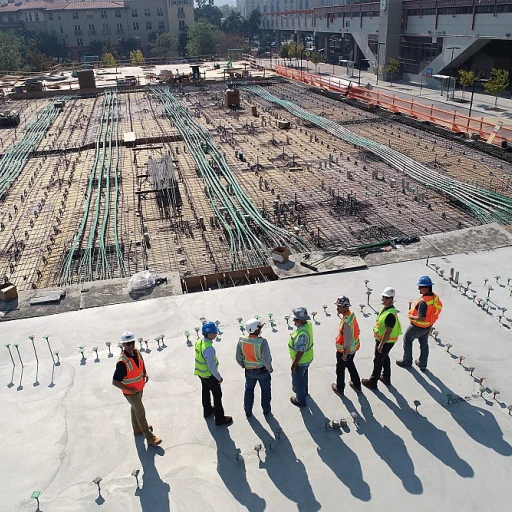
Understanding the Future of Work
Rethinking the Workplace Landscape
Employee performance is at the core of a successful business, and in today’s evolving landscape, it demands a fresh perspective. The future of work is characterized by a shift towards remote and hybrid work environments, which necessitates a re-evaluation of traditional performance improvement methods. This dynamic shift brings with it new challenges, but also incredible opportunities for growth.
Understanding Employee Performance in a Modern Context
As physical boundaries blur and digital communication takes precedence, employee expectations and performance metrics must be readjusted. The traditional 9-to-5 office job is becoming a thing of the past, and with it, so are outdated performance goals. Organizations need to realign their performance improvement plans (PIPs) with contemporary needs. This includes setting clear, achievable expectations and creating a plan template that can adapt to the remote work culture.
Clear Expectations and the Role of Feedback
One key to enhancing employee performance is establishing clear expectations for both employees and the team. It's essential that all team members understand what their roles entail and how their work contributes to the company's overarching goals. Regular check-ins and feedback sessions can lead to significant improvement in employee performance, ensuring that any performance issues are addressed promptly and effectively.
Moreover, incorporating feedback mechanisms into the process can foster a culture of continuous improvement. This structured approach to employee performance not only guides individuals but also ensures that organizations stay competitive in an ever-changing market.
Adapting to the Future Work Models
As organizations look to the future, embracing flexible work models will be crucial. Performance improvement plans must be adaptable to remote and hybrid work settings, taking into consideration the unique challenges and benefits these models offer. Crafting effective PIP processes, designed to improve performance irrespective of the work setting, will lead to a motivated and productive workforce.
In conclusion, understanding the future of work involves recognizing the need for change in performance management strategies. By setting clear expectations, fostering regular interactions, and adapting improvement plans to fit the future workplace landscape, organizations can set their employees on a path to success.
The Role of Performance Improvement Plans
Understanding Performance Improvement Plans in the Modern Workplace
Performance improvement plans, often abbreviated as PIPs, are essential components of performance management strategies aimed at assisting employees in overcoming performance issues. These structured plans provide a tailored roadmap for employee improvement, focusing on setting clear expectations and achievable performance goals. As workplaces evolve, understanding the role of improvement plans becomes increasingly crucial for both employers and employees alike. PIPs are generally utilized when an employee's job performance does not meet the established standards. They act as a formalized action plan with specific objectives designed to aid the employee improve their overall performance. An effective performance improvement plan should also include regular check-ins to monitor progress and adjust goals, if necessary, to ensure alignment with company expectations. Incorporating feedback and fostering open communication is fundamental to the success of any improvement plan. Providing frequent, constructive feedback ensures that employees understand where they stand and what areas require attention. Moreover, it encourages a culture of continuous improvement and growth, benefiting not only the individual employee but the team and organization as a whole. The role of a performance improvement plan extends beyond just addressing issues; it is a valuable tool for steering employees towards success and maximizing their potential. When approached with the right mindset, PIPs can transform performance challenges into opportunities for development. As the future of employee engagement evolves, exploring effective strategies like the PIP becomes indispensable for ensuring a thriving, productive workforce. More insights on forward-thinking practices and employee-centric strategies can be found in our future of employee engagement blog post. By understanding and implementing successful performance improvement plans, organizations can elevate their teams, foster positive workplace dynamics, and ultimately drive better results.Crafting an Effective Performance Improvement Plan Template
Essential Steps in Designing a Robust Template for Improvement
Crafting an effective performance improvement plan requires a strategic framework that sets clear expectations and outlines specific actions to remedy performance issues. Anchoring this process in a well-constructed template can not only enhance employee performance but also foster a structured environment for improvement.
A comprehensive template should be adaptable, providing room for customization based on individual team members and their unique challenges. Here are some crucial aspects to include when creating your template:
- Clearly Defined Performance Goals: The foundation of any successful improvement plan is the establishment of clear, measurable goals that align with the employer’s objectives. This alignment ensures that employees understand what is expected from them and how it connects to the organization's broader strategy.
- Actionable Steps and Resources: Break down the overarching goals into smaller, manageable tasks. Including specified training opportunities, resources, or support mechanisms can bridge the gap towards achieving improvement.
- Regular Check-Ins and Feedback: Embedding scheduled check-ins into the template facilitates ongoing communication between the employee and supervisor. These sessions serve to assess progress and offer constructive feedback, ensuring both parties are aligned on the PIP process.
- Timeline and Milestones: Setting a clear timeline with interim goals helps in maintaining momentum and gauging progress over time. It provides an organized framework for the employee to follow and for the team leader to monitor.
- Resolution Criteria: Define what successful completion of the plan looks like. This criterion should be objective, measurable, and known to employees from the outset, allowing them to understand when issues have been sufficiently resolved.
A robust PIP template is not just about addressing current performance issues, but it also helps improve the overall performance management of the organization. By offering a structured, clear outline with regular feedback loops and definitive expectations, teams can ensure that employees have the opportunity to rectify issues and contribute positively to the company's goals. Additionally, in adapting to evolving work environments, the flexibility of the template allows for remote and hybrid work setups, making it an essential component in the modern workplace landscape. For more insights, read about the expected shift in workplace norms.
Adapting Improvement Plans for Remote and Hybrid Work Environments
Tailoring Performance Improvement Plans to Remote Work Settings
In today's rapidly evolving work landscape, adapting performance improvement plans to suit remote and hybrid environments has become essential. As remote work continues to gain traction, the need for well-structured performance improvement strategies that align with these new dynamics is clear. Ensuring that your performance improvement plan (PIP) acknowledges the unique challenges remote employees face can significantly improve overall employee performance. One of the key components is establishing crystal-clear expectations. In virtual settings, communication can easily become fragmented, leading to misunderstandings. Clear goals and performance expectations should be clearly outlined in your plan template. This helps your team members understand what is expected of them and how their progress will be evaluated over time.Incorporating Regular Check-Ins and Feedback Mechanisms
Regular check-ins and feedback loops are vital in remote work environments. While traditional in-office settings allow for spontaneous interactions, remote setups require intentional engagement. Consistent virtual meetings or feedback sessions keep communication lines open, allowing employees to discuss their performance progress and address any issues. Providing constructive feedback is crucial for employee improvement. Use these check-ins to review progress made against performance improvement plans and to adjust goals as needed. This ensures that your employees remain motivated and aligned with the organization's objectives.Leveraging Technology for Effective PIP Management
Utilizing the right technology is instrumental in managing performance issues in remote settings. Performance management software can streamline the PIP process, providing a centralized platform for tracking progress, setting objectives, and facilitating communication between team members and managers. Through these platforms, you can easily manage your action plan and ensure that employees have access to necessary training resources to address performance gaps. Tailor your PIP template to incorporate tools that facilitate remote collaboration and project management effectively.Encouraging Flexibility and Support
Remote employees may face unique challenges that go beyond typical job performance issues. By fostering a culture that emphasizes support and adaptability, you empower employees to overcome hurdles and enhance their contribution to the team. Ensure your performance improvement plan includes provisions for offering support, whether it's through additional resources, mentoring, or flexible work arrangements. Promoting a supportive environment will not only help individuals improve performance but also build a stronger, more resilient workforce.Leveraging Technology in Performance Improvement
Maximizing Efficiency with Technological Tools
In the modern workplace, technology plays a pivotal role in enhancing both employee performance and the efficacy of performance improvement plans (PIPs). Implementing the right technological tools can streamline the process of performance management, making it more efficient and effective. Incorporating technology into your improvement plans allows for:- Regular Check-ins: Digital platforms can facilitate regular check-ins by automating reminders and providing a structured framework for discussions. This ensures consistency and reinforces the importance of progress and feedback.
- Tracking Progress: Performance tracking software offers a clear view of employee progress over time. Designed with intuitive dashboards, these tools make it easy to monitor achievements and identify any persistent performance issues.
- Setting Clear Expectations: With the help of performance management tools, clear goals and expectations can be communicated more effectively. Employees can access PIP templates and guidelines online, ensuring that expectations are both understood and actionable.
- Enhanced Feedback Loops: Leveraging technology enables a robust feedback mechanism. These platforms can gather, analyze, and present feedback effectively, fostering a culture of continuous improvement and open communication within the team.
- Training and Development: Online training modules integrated with improvement plans can provide personalized learning paths. This helps employees acquire the necessary skills to improve their performance and align with their performance goals.












